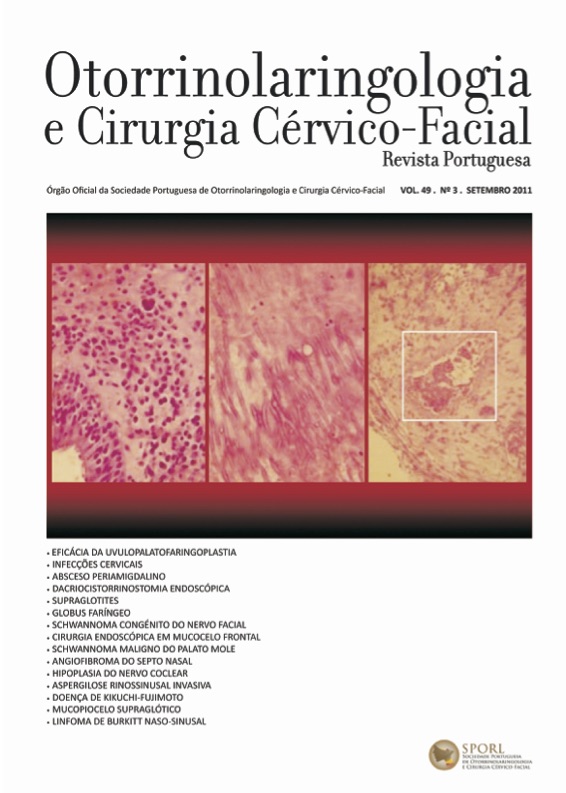Globus faríngeo: Revisão da literatura
DOI:
https://doi.org/10.34631/sporl.177Palavras-chave:
globus, refluxo faringolaríngeo, refluxo gastroesofágico, diagnóstico, tratamentoResumo
O Globus é a sensação de corpo estranho na faringe. É um sintoma extremamente frequente contribuindo para 4% das primeiras consultas ORL.
Ainda mal compreendido e frequentemente atribuído ao refluxo gastroesofágico e faringolaríngeo, não existe consenso quanto ao seu diagnóstico e tratamento. São revistos os últimos desenvolvimentos e trabalhos recentes sobre o Globus discutindo aspectos da sua etiopatogenia e da abordagem.
Downloads
Referências
Khalil H. The Diagnosis and Management of Globus: a perspective from the United Kingdom. Curr Opin Otolaryngol Head Neck Surg 2008;16:516-520.
Webb CJ, Makura Z, Fenton J, et al. Globus Pharyngeus: a Postal Questionnaire Survey of UK ENT Consultants. Clin Otolaryngol 2000;25:566-569.
Park KH, Choi SM, Kown SU et al. Diagnosis of Laryngopharyngeal Reflux among Globus Patients. Otolaryngol Head Neck Surg 2006Jan;134(1):81-85.
Deary IJ, Wilson JA, Harris MB et al. Globus Pharyngis: Deveolpment of a Symptom Assessment Scale. J Psychosom Res 1995;39(2):203-213.
Cathcart R, Wilson JA. Lump in the Throat. Clin Otolaryngol 2007;32:108-110.
Remacle M. The Diagnosis and Management of Globus: a Perspective from Belgium. Curr Opin Otolaryngol Head Neck Surg 2008;16:511-515.
Caylakli F, Yavuz H, Erkan A, et al. Evaluation of Patients with Globus Pharyngeus with Barium Swallow Pharyngoesophagography. Laryngoscope 2006Jan;116:37-39.
Burns P, O´Neill JP. The Diagnosis and Management of Globus: a Perspective from Ireland. Curr Opin Otolaryngol Head Neck Surg 2008;16:503-506.
Rival R, Wong R, Mendelsohn M et al. Role of Gastroesophageal Reflux Disease in Patients with Cervical Symptoms. Otolaryngol Head Neck Surg 1995Oct;113(4):364-369.
Anandasabapathy S, Jaffin BW. Multichannel Intraluminal Impedance in the Evaluation of Patients With Persistent Globus on Proton Pump Inhibitor Therapy. Ann Otol Rhinol Laryngol 2006;115(8):563-570.
Bajbouj M, Becker V, Neuber M, et al. Combined pH-Metry/Impedance Monitoring Increases the Diagnostic Yield in Patients with Atypical Gastroesophageal Reflux Symptoms. Digestion 2007;76:223-228.
Fornari F, Sifrim D. Gastroesophageal Reflux and Atypical Symptoms: The Role of Impedance-pH Monitoring. Digestion 2007;76:221-222.
Woo P, Noordzij P, Ross J. Association of Esophageal Reflux and Globus Symptom: Comparison of Laryngoscopy and 24-hour pH Manometry. Otolaryngol Head Neck Surg 1996Dec;115(6):502-507.
Ott DJ, Ledbetter MS, Koufman J et al. Globus Pharyngeus: Radiographic Evaluation and 24-hour Monitoring of the Pharynx and Esophagus in 22 Patients. Radiology 1994;191:95-97.
Chen C, Tsai C, Chou AS et al. Utility of Ambulatory pH Monitoring and Videofluoroscopy for the Evaluation of Patients with Globus Pharyngeus. Dysphagia 2007;22:16-19.
Oridate N, Nishizawa N, Fukuda S. The Diagnosis and Management of Globus: a Perspective from Japan. Curr Opin Otolaryngol Head Neck Surg 2008;16:498-502.
Knight R, Wells J, Parrinsh R. Esophageal Dysmotility as an Important Co-factor in Extraesophageal Manifestations of Gastroesophageal Reflux. Laryngoscope 2000Sep;110:1462-1466.
Postma G, Cohen J, Belafsky P, Halum S et al. Transnasal Esophasgospcy: Revisited (over 700 Consecutive Cases). Laryngoscope 2005Feb;115:321-323.
Koufman J, Aviv J, Casiano R et al. Laryngopharyngeal Reflux: Position Statement of the Comittee on Speech, Voice, and Swallowing Disorders of the American Academy of Otolaryngology-Head and Neck Surgery. Otolaryngol Head Neck Surg 2002Jul;127(1):32-35.
Rowley H, O´Dwyer TP, Jones AS et al. The Natural History of Globus Phrayngeus. Laryngoscope 1995;105:1118-1121
Oridate N, Takeda H, Asaka M et al. Acid-suppression Therapy Offers Varied Laryngopharyngeal and Esophageral Symptom Relief in Laryngopharyngeal Reflux Patients. Dig Dis Sci 2008;53:2033-2038.
Belafsky PC, Postma GN, Koufman JA. Laryngopharyngeal Reflux Symptoms Improve Before Changes in Physical Findings. Laryngoscope 2001Jun;111(6):979-981.
Sala E, Salminen P, Simberg S et al. Laryngopharyngeal Reflux Disease Treated with Laparoscopic Fundoplication. Dig Dis Sci 2008;53:2397-2404.
Karkos PD, Benton J, Leong SC et al. Trends in Laryngopharyngeal Reflux: a British ENT Survey. Eur Arch Otorhinolaryngol 2007;264:513-517.
Karkos PD, Janet A. Empiric Treatment of Laryngopharyngeal Reflux with Proton Pump Inhibitors: A Systematic Review. Laryngoscope 2006Jan;116:144-148.






